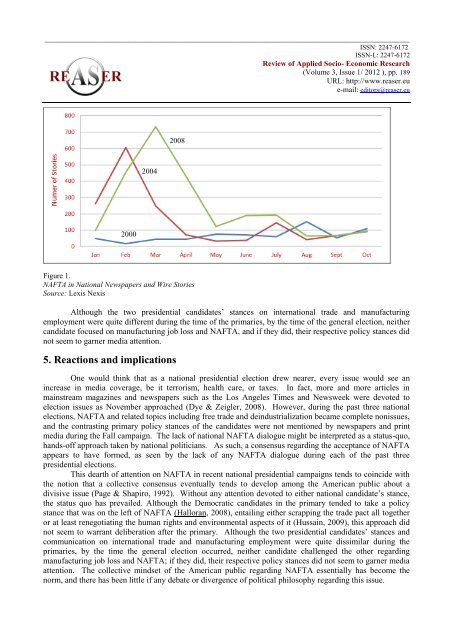Volume 3, ISSUE1/2012 - Review of Applied Socio-Economic ...
Volume 3, ISSUE1/2012 - Review of Applied Socio-Economic ...
Volume 3, ISSUE1/2012 - Review of Applied Socio-Economic ...
Create successful ePaper yourself
Turn your PDF publications into a flip-book with our unique Google optimized e-Paper software.
________________________________________________________________________________________________<br />
ISSN: 2247-6172<br />
ISSN-L: 2247-6172<br />
<strong>Review</strong> <strong>of</strong> <strong>Applied</strong> <strong>Socio</strong>- <strong>Economic</strong> Research<br />
(<strong>Volume</strong> 3, Issue 1/ <strong>2012</strong> ), pp. 189<br />
URL: http://www.reaser.eu<br />
e-mail: editors@reaser.eu<br />
2008<br />
2004<br />
2000<br />
Figure 1.<br />
NAFTA in National Newspapers and Wire Stories<br />
Source: Lexis Nexis<br />
Although the two presidential candidates’ stances on international trade and manufacturing<br />
employment were quite different during the time <strong>of</strong> the primaries, by the time <strong>of</strong> the general election, neither<br />
candidate focused on manufacturing job loss and NAFTA, and if they did, their respective policy stances did<br />
not seem to garner media attention.<br />
5. Reactions and implications<br />
One would think that as a national presidential election drew nearer, every issue would see an<br />
increase in media coverage, be it terrorism, health care, or taxes. In fact, more and more articles in<br />
mainstream magazines and newspapers such as the Los Angeles Times and Newsweek were devoted to<br />
election issues as November approached (Dye & Zeigler, 2008). However, during the past three national<br />
elections, NAFTA and related topics including free trade and deindustrialization became complete nonissues,<br />
and the contrasting primary policy stances <strong>of</strong> the candidates were not mentioned by newspapers and print<br />
media during the Fall campaign. The lack <strong>of</strong> national NAFTA dialogue might be interpreted as a status-quo,<br />
hands-<strong>of</strong>f approach taken by national politicians. As such, a consensus regarding the acceptance <strong>of</strong> NAFTA<br />
appears to have formed, as seen by the lack <strong>of</strong> any NAFTA dialogue during each <strong>of</strong> the past three<br />
presidential elections.<br />
This dearth <strong>of</strong> attention on NAFTA in recent national presidential campaigns tends to coincide with<br />
the notion that a collective consensus eventually tends to develop among the American public about a<br />
divisive issue (Page & Shapiro, 1992). Without any attention devoted to either national candidate’s stance,<br />
the status quo has prevailed. Although the Democratic candidates in the primary tended to take a policy<br />
stance that was on the left <strong>of</strong> NAFTA (Halloran, 2008), entailing either scrapping the trade pact all together<br />
or at least renegotiating the human rights and environmental aspects <strong>of</strong> it (Hussain, 2009), this approach did<br />
not seem to warrant deliberation after the primary. Although the two presidential candidates’ stances and<br />
communication on international trade and manufacturing employment were quite dissimilar during the<br />
primaries, by the time the general election occurred, neither candidate challenged the other regarding<br />
manufacturing job loss and NAFTA; if they did, their respective policy stances did not seem to garner media<br />
attention. The collective mindset <strong>of</strong> the American public regarding NAFTA essentially has become the<br />
norm, and there has been little if any debate or divergence <strong>of</strong> political philosophy regarding this issue.








